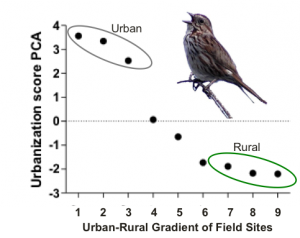
Human habitat disturbance is now recognized as impacting the phenotypes of wild animals and is a particular concern for wild birds. Though some species are threatened by human habitat disturbance, many animals adjust their behavior and physiology through phenotypic plasticity to cope with environmental change. Such plasticity is often sufficient to permit animals to adjust to changing environmental conditions and behavior can be the first means by which animals respond to ecological change in an effort to maintain homeostasis.
Endocrine mechanisms are a major link between organisms’ perceptions of environmental conditions and behavioral and physiological responses and, thus, play a central role in mediating phenotypic plasticity. There is an urgent need to understand the endocrine mechanisms that permit animals to cope with changing environments because understanding the proximate basis of phenotypic adjustments to habitat disturbance will shed light on why some species persist and others decline when faced with a changing environment. Reciprocally, determining how novel environmental conditions alter endocrine phenotypes provides insight into the function and evolution of these mechanisms.
Our lab studies song sparrows living along a rural-urban gradient around Blacksburg, VA. We have found that urban song sparrows are more aggressive than their rural counterparts and that stress hormones (glucocorticoids) and activation of the social behavior network in the brain, but not testosterone, may underpin this behavioral difference.
